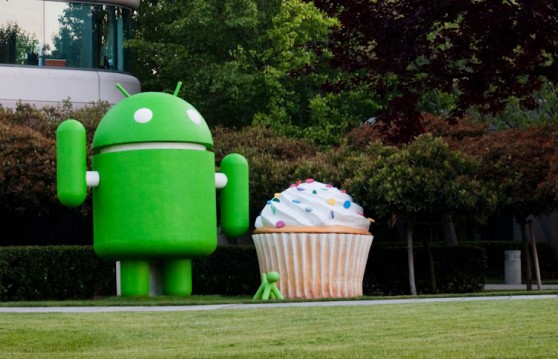Ricky Ahuja is the President of Affiliate Venture Group, named this year as one of the top three CPA affiliate networks . He talks to Murray Newlands of PMI-TV about how Affiliate Venture Group has grown over the last few years especially because of their acceptance of international traffic, especially with a focus on traffic from India. He goes in depth on why working in India is working, making them a lot of money and how to manage any special international relationships. Definitely an interesting interview from a leader in the industry on how he’s grown his company while facing stiff competition.
Google Android Still King, For Now
Since the release of the iPhone 5 and iOS 6, I have been patiently waiting to find out some new results on the status of the mobile market. Sure, there are plenty of sites to get this information from, but there is one report in particular that I have been waiting for, and now it has arrived. When comScore reports the findings of their MobiLens service, as they did today, I am always curious about one thing in particular; the everlasting competition between Google Android and Apple iOS. However, their MobiLens findings include more than just the status of the race to the top of the platform market.
However, for this platform battle, Google seems as though it cannot be beat. In their findings from May of 2012, comScore reported that Android accounted for 50.9% of all smartphone subscribers. Now, the company is reporting that for August of this year, Android has 52.6% of the total of all smartphone subscribers. Apple, on the other hand had only 31.9% in May 2012, and for August, their percentage went up to 34.3%. The rest of the listed platforms (RIM, Microsoft, Symbian) went down in percentage from their May 2012 numbers, which is where the growth of the two biggest names came from. However, as you may have noticed, Apple grew more in terms of percentage points than did Android. Where Android only grew 1.7 points, Apple grew 2.4.
The findings also covered mobile content use for August of 2012, which will tell marketers just what people are doing on their smartphones while pondering their next move in their mobile marketing campaigns. Here is what comScore wrote in their page of highlights for their findings;
In August, 75.6 percent of U.S. mobile subscribers used text messaging on their mobile device (up 0.8 percentage points). Downloaded applications were used by 53.4 percent of subscribers (up 2.3 percentage points), while browsers were used by 52 percent (up 2.2 percentage points). Accessing of social networking sites or blogs increased 1.6 percentage points to 38.3 percent of mobile subscribers. Game-playing was done by 34 percent of the mobile audience (up 0.5 percentage points), while 28.3 percent listened to music on their phones (up 1.3 percentage points).
The greatest point changes from May to August came with the use of downloaded apps, with a 2.3 point change, use of a mobile internet browser with a 2.2 point change, as well as accessing social networks via mobile apps or blogs with a 1.6 point change. All of these changes were in the positive direction, giving hope to marketers who have been spending ad dollars marketing in these three mobile areas specifically.
It is findings like these that help marketers keep up to date with the happenings of the mobile market, helping them to make decisions and not mess up. From these findings, we can see that Google is still strong at the top, and that people are using their phones for a lot more than just texting these days. It will be interesting to see the next set of findings from comScore, where Apple’s new device and operating system will come in to play.
Social Media Looking Good: Accomplishments for Twitter, Facebook, and Tumblr
Today is a day filled with accomplishment and success in the realm of social media. A number of things went on today in regard to social media, each of which is beneficial and shows further growth for social media as a whole. For one, the more famous occurrence of the day was Facebook’s accomplishment of reaching a monthly active user base of 1 billion users.
This morning, there are more than one billion people using Facebook actively each month.
If you’re reading this: thank you for giving me and my little team the honor of serving you.
Helping a billion people connect is amazing, humbling and by far the thing I am most proud of in my life.
I am committed to working every day to make Facebook better for you, and hopefully together one day we will be able to connect the rest of the world too.
However, Twitter released some good news last night that has spread all over the web today as well. Following and during last night’s presidential debate, Twitter hit the record books once again. Here is the Tweet that was tweeted by @twittercomms, Twitter’s communications account;
Tonight’s debate was the most tweeted about event in US political history, topping the numbers from the RNC and DNC.
Both Facebook and Twitter reached some pretty magnificent milestones last night. I guess this is why marketers tend to divert all of their attention to these two networks, because of the sheer growth and results that they see. With the accomplishments that these two networks met last night and today, I think it is safe to say they will remain the center of attention for a while.
Obviously though, there has got to be some reason that marketers are still lending their attention to other social media networks, like Tumblr for example. Tumblr never really seemed like a great place for advertising when it first came into the world, but after a while they have grown into something that marketers can use. Well today, the people at Tumblr have taken things a step further for their potential marketing clients. With a new partnership between the company and Union Metrics, a company that measures the impact of ads in a social media setting, Tumblr has allowed marketers to see just what they are getting from their effort with the site.
Union Metrics for Tumblr reporting includes:
- Post and note volume to show overall engagement levels and trends over time
- Top contributors and curators to help identify key influencers
- Analysis of posts and tags to surface most popular posts
- Post engagement details, including the full reblog tree and interactions over time
Needless to say, it was a great day for social media, and all of the good news should be music to a marketer’s ears. Most marketers have some form of advertising or marketing on any number of social media networks, so knowing that they are all doing exceptionally well should feel good. In other words, things are continuing to look up with social media.
Mobile Music Expected to Grow, Games Still Lead
If mobile devices were available during the 60s and 70s, I can only imagine what the numbers would look like, regarding revenue from mobile music platforms. However, according to eMarketer, they are not looking too bad this year either. Better yet, eMarketer predicts a pretty significant growth in revenue from mobile music by 2016, which is their year of choice for their countless predictions and forecasts. Here is their exact prediction, from their article which was published today:
Advertising revenues, which already make up the bulk of US mobile music revenues, will gain an even greater share in the coming years, eMarketer forecasts, and by 2016 will account for more than 86% of all such revenues.
They report that as of today, the percentage of revenues is not really anywhere near that, at 69%. However, this is still a huge majority over things like subscription-based music services like Pandora and Spotify, or per-download fees. Such subscription-based services only account for 17.2% of the total revenue brought in from mobile music, while per-download fees only amount to 14.1% of total mobile music revenues. Since advertising with mobile music already brings in the majority of mobile music revenue, it may prove to be something that is worth looking into sometime soon.
Even by 2014, eMarketer has predicted that mobile music ad revenue will account for 82.2% of all mobile music revenue, which is already significantly higher than the 69% of this year. However, it is not mobile music that will lead the way in mobile content revenues by 2016. As of right now, the leading generators of content revenue are games, accounting for 43% of US mobile content revenue. Games’ leading the way in content revenue is a trend that will continue through 2016, according to eMarketer.
This will still leave music as the smallest source of mobile content revenues, compared with video and games, though its share in 2015 will be 7 percentage points greater than this year. Gaming commands a plurality of revenues, at 43% of the total in 2012 and hovering around that amount through the end of the forecast period, while video revenues will shrink from more than half of revenues in 2010 to less than a third by 2016. This year, revenues from mobile games will reach $1.08 billion, compared with $1 billion from video.
While mobile music is expected to reach$ 1.68 billion in revenue by the year 2016, gaming is already expected to reach $1.08 billion by this year. When considering the growth of both of these types of content is expected to be enormous, gaming will far out-do music in 2016, just as it has this year.
Still though, the improvement of mobile music advertising is somewhat exciting. Even though it is not the top content revenue generator, it is still seeing growth, and growth is always good. Content marketing is a very strategic process, and with a third eligible candidate for successful results, things could potentially get a bit more interesting for marketers that are interested in it.
Why RTB Media Buying Works
Sean Berman of engage:BDR talks with Murray Newlands about how engage:BDR buys inventory and helps publishers monetize their traffic, while at the same time hitting their advertiser’s CPA goals. He talks about how much of the advertising on the internet is junk, below the fold like “midnight commercials” of sorts that have no performance value whatsoever. He gives a few examples of what has worked, what clients are making money, and how they are generating positive ROIs.
Sponsored Exclusively by engage:BDR
Cheap Affiliate Management Does Not Work
More often than not, companies that are not happy with the state of their affiliate program and/or their manager are struggling for one reason: they’re not devoting enough time and resources to the management of the program. In an effort to keep the total costs of their affiliate program low, many companies nit-pick the dollars spent on a third party agency or Outsourced Program Manager (OPM) rather than evaluating whether the fees for program management are justified through successful program performance.
Typically, marketing managers are far too focused on their OPM costs, which usually run under $3k a month, and are not paying nearly enough attention to the total cost of the program, which can run into millions of dollars. Thinking about the management costs of an affiliate program separately from the total cost of the program can be a costly mistake, as poor management can dramatically drive up the program’s total cost. Conversely, efficient and creative management of resources and talent can significantly impact a program’s performance.
The reality with most affiliate programs is that companies are getting exactly what they pay for with their management choice.
Firms that offer affiliate management services for a few thousand dollars a month usually operate in one of two ways. A smaller OPM often has an overstretched founder along with processes and people that do not scale, resulting in poor performance for non-core programs. Mid-size and larger OPM’s have figured out how to scale, but to do so they usually have to employ low-cost, inexperienced program managers and assign them to 10+ accounts, ensuring that each client program gets little to no quality attention. Incentives at these firms are often tied to the number of programs managed. Careful examination reveals that OPM’s with the highest manager-to-program ratios charge the least.
Another major downside of affiliate “McManagement” is that quantity-focused program managers, looking to make the program look good, go for the easy revenue.
They pay hefty commissions to low-value affiliates which include coupon sites, incentive sites, and loyalty and toolbar sites in order to show the perception of top-line growth. These affiliates often target customers that might have purchased from the brand directly and can potentially damage the effectiveness of other marketing channels. Also, when top-line growth is the focus, there is no incentive to control costs, even though the manager is making decisions virtually at will with their clients’ dollars that are being spent on commission and network fees.
By paying a higher fee to a reputable agency that is more engaged, companies generally get a stronger, more experienced affiliate management team that is focused on fewer programs. These teams are spending time building 1:1 relationships with higher-quality affiliates such as blogs, product feed sites, and content-based daily deal sites. They are also segmenting affiliates so that the highest quality (not highest volume) affiliates are paid more and low quality affiliates (which are often high volume) get lower commission rates.
Additionally, with this more time-consuming approach, companies save money on affiliate network fees, because the network fees are based on commissions paid. (This is also an important reason why every company should think twice before hiring an affiliate network-based manager, as there are inherent conflicts of interest with the network’s economics and management responsibilities).
Here is an example of how this plays out based on an actual “before and after” example related to total program costs for Acme Company.
- Scenario 1. Acme’s affiliate program has been managed by lower-cost OPM 1, as Acme believed that they could get a lot of value for very little cost. OPM 1 charged $3,000 and the account was managed by someone with one to two years of experience who also has nine other accounts to oversee simultaneously.
- Scenario 2. Acme brings in a higher cost and more talented, sophisticated agency/management team, OPM 2. They see it as an investment and want a focus on total program profitability. OPM 2 assigns a senior director with a support team to the account, and the firm focuses on only a handful of programs at a time.
On the flip side, Acme spends more money on experienced, sophisticated OPM 2 who gives their program significantly more time, energy and focus and whose managers’ success and compensation is not tied to the number of programs managed. Although they are now paying three times as much for the management, they ultimately save $265,000 – about 20% – because of the benefits brought by their team’s ability and the mandate to focus on the cost side of the equation. It is also important to note that this example is only focused on cost, and not the difference in quality of the revenue. When revenue quality is considered, the disparities are even more greatly magnified.As you can see, initially Acme is saving $60K annually on management fees, but this savings actually comes at a significant cost in other areas. Even though the company’s affiliate program revenues are identical under both scenarios, there is a big difference in the total money spent ($265,000) because OPM 1’s team lacks the experience necessary to really understand how a high-quality affiliate program should be run. With OPM 1, Acme ends up making substantial commission payouts to low-quality affiliates, and by extension to the network as well. It should also be noted that Acme was essentially entrusting a $9.2 million channel to the equivalent of a $30K year employee. In no other marketing channel would this even be considered—in fact, any other channel of this size would almost certainly have a senior manager and/or a supporting team.
Fundamentally, in the affiliate industry, as in most things, you really do get what you pay for. Make sure to keep the big picture in mind as you decide who will manage you program.
Google Display Network: New LightBox Ads; Engagement is Up
One of the more prominent advertising options that Google offers to its marketing customers is display advertising. The company has, for some time now, been leading the way in successful display advertising, and most marketers get the performance that they are looking for out of these display ads. Now, Google has decided to take their display offerings a step further, by releasing a new format for display ads. In a blog post today, Google announced this new display ad option and they also wrote a bit about engagement in advertising and helping brands see their fullest potential on the web. It is a pretty stacked post, so I will give you some of the major points, here.
Google’s new display advertising format is one that already exists, but the idea is new to the company. These ads are in a lightbox format, allowing for marketers to pay only upon engagement from a user. However, these lightbox ads have some pretty unique features, as were described in the blog;
The lightbox starts as a standard display ad, making it scalable, but after a two-second hover, expands to a super-sized canvas. In internal tests, we’ve seen that this smart hover feature eliminates nearly 100% of accidental expansions and increases engagement by 6-8X over standard click-to-expand ads. The result: users only engage with the ads they really want to see and brand marketers only pay for truly engaged views.
Another thing that Google has announced today was their recent findings from a study conducted recently. Apparently, upon looking at the impact during as well as two weeks after 92 ad campaigns, Google found out that their ads on YouTube, such as the TrueView video ads, as well as ads from their Google Display Network were seeing substantial results. On average, every $1 spend on YouTube ads returned $1.70 in sales. This was 2.4x more efficient than the television spend for these campaigns.
These ads also help achieve branding goals: we found, on average, that ads on YouTube and the Google Display Network drive a 36% increase in visits to your website and a 36% increase in searches for your brand online (Google Internal Data, 2012)
Speaking of brands, Google continued to speak about what they have been doing to help brands grasp the full potential of their advertising efforts. Not only has the company been helping brands, they have actually created a real, physical space for brands and Google to meet face-to-face to discuss everything and anything marketing. The new “BrandLab,” is located at Google’s YouTube headquarters, where they have already had quite a few well-known brands as visitors.
In one post, we have pretty much been let into the world of Google, as far as what they have been up to for the past months. With all these new options and all this new information that Google has released for advertisers and marketers, they will have opened up quite a bit of intrigue in their company’s advertising business. As if Google’s Display Network was not helpful enough, it has improved even more.
Response Based Targeting Works for Marketers
In a down economy, marketing budgets suddenly become extremely expendable. Typically, they make a company’s list of “Top 5 Areas to Slash and Burn.” Yet, affiliate marketers still need to squeeze out a greater ROI with the shredded remnants, right? Why not ensure these precious ad dollars land where they can get the most green for the go? Using response-based targeting is one way to do this.
When it comes to potential customers, marketers may not be dealing with who they think they are dealing with. While a product may be marketed toward a specific audience, that doesn’t mean that every person clicking through the ad and ultimately making a purchase is a member of that group. Relying solely on demographic or psychographic data may exclude a whole segment of potential sales. Response-based targeting can help marketers reveal this potential.
With response-based targeting, a product is presented to consumers who have been the most responsive to specific advertising efforts, regardless of their demographic/psychographic profile. To gain this information, sales data must be analyzed for patterns that reveal which customers purchased the product because of their exposure to advertising or based on previous shopping habits. Once those patterns are set, data is organized in order from most responsive to least responsive. Voilà! Often times, the data determines that an entirely different population of consumers is responding and buying. That is exactly why Adknowledge uses response-based targeting with its affiliate marketers – to unlock the hidden money-making potential for its clients.
Migrating from the current comfy-cozy target marketing strategy to response-based marketing might require a major shift in thinking. Before taking the leap, conduct a little research. Determine which offers from the past year performed best and why. Look for buying patterns during those times, and use that research to help you decide if a change is needed.
Response-based targeting isn’t without its pitfalls. Affiliate marketers should keep the value of the customer vs. the cost to advertise in mind to avoid overspending. It’s a bit of a balancing act, and careful data analysis is essential. Even if the numbers suggest a move into pricier media outlets, it may not be the right move, at least not right now. Using a combination of response-based marketing and demographic/psychographic marketing methods might make the most sense. At the very least, analyzing sales data using a response-based approach is worth the time and effort.
PMI members, get a 50% revenue bonus at ADK- http://lm.adknowledge.com/li03/
Not Matter How Small You Got Game
There is a lot of talk in our industry about who is making the most money, who is the biggest “baller” and other crap like that. Let’s put this in perspective: most of the people, most of the affiliates are just trying to make living, not trying to buy their newest Bentley. I’ve been fortunate that over the last 15 years I’ve made tens of millions personally in the industry, and my companies have made hundreds of millions.
However, we need to have a lot of respect fort he “little guys” in our industry, those who are being innovative, trying new things, helping to grow the industry.
What’s even more interesting is where these guys are coming from: India, Pakistan, Mexico and many other countries. These guys may not be making millions, or even tens of thousands, but the income they do make, can make a huge difference in their life in those countries. It allows them to buy a house, get a car, send their kids to school and even help their community. I talk to some of these guys daily, and their stories are amazing.
Here’s an inspirational video of Mani Love, a 4’5 basketball player who can do stuff that most of us can’t even imagine. If he can do this, anyone can make it in performance and affiliate marketing with hard work and determination.
Sponsored by ClickDealer: Where anyone can make it
![]()
Get Conversions from Twitter
Twitter is the place people to go and catch up on everything and anything that their friends, family, and any other person or page they might be following is up to. Brands know that, which is why most of them have hopped into the trend that is a Twitter account. Promoted Tweets have seemed to be one of the more successful ways to advertise using the network since they were announced to the world earlier this year. Today, though, there are those that think that Promoted Tweets are not the big ticket item for Twitter advertisers and they there is another way to advertise on Twitter that may be the future of Twitter marketing. The best part of it all is that Twitter makes no money off of because it’s a marketing method that brands will never have to pay for.
An article from TechCrunch reveals some important information that they were told by Joel Lunefeld, Twitter’s vice president of global brand strategy. Joel informs us that at least one in six Twitter users follows at least one brand, be it for a chance to receive discount promotions or just to simply keep up with what the on goings are for certain brands. This is important for many reasons, but the reason Lunefeld said this is very specific.
“The big message of Lunenfeld’s talk was to encourage advertisers to understand that advertising on Twitter isn’t separate from regular content. Brands should think of conversations on Twitter as a canvas where “you can paint some amazing stories,” he said.”
So, basically he is encouraging brands to market on Twitter for free more often, which seems like a pretty dumb idea in the sense of Twitter making money. However, regardless of this encouragement, conversation of brands on Twitter and Promoted Tweets are things that could work together quite nicely, so that Twitter makes money while marketers get the results they need. The idea here is that brands having actual conversations on Twitter, with other brands or other businesses, could bring potentially more conversions than Promoted Tweets in some cases.
Here’s an example that Lunefeld gave, as reported by TechCrunch.
A tweet from Old Spice asking, “Why is it that ‘fire sauce’ isn’t made from real fire? Seems like false advertising.” To which Taco Bell responded, “Is your deodorant made with really old spices?” (Old Spice: “Depends. Do you consider volcanos, tanks, and freedom to be spices?”)
These two brands are not competitors, so this type of witty banter back and forth can only benefit the two of them equally. For anyone who is following either brand, it would be exciting to see two well-known brand names battling back and forth with witty banter and potentially insulting remarks. In the case above, I’m sure it was all out of good fun, and the conversation will get people interested in both brands. It is sort of a type of advertising that can only exist on Twitter, with their hash tags and public responses. Either way, I think Lunefeld has a good idea here, saying that conversation may be a new way to bring in conversions and overall better results from Twitter marketing.
Apple’s Damaging their Location-Based Marketing?
While reading the countless articles that were smashing and tearing apart the recent flop by Apple that is their new map application, I stumbled upon an article that made a point that some people are missing. Sure consumers and marketers hate the new maps, but the problems that have been occurring with Apple’s new location services could pose an even larger problem for marketers. Location-based targeting and localized location marketing have been rapidly growing recently, and with such dependence from the consumer on mobile devices and mobile media, mobile location-based targeting is something that has been becoming and will continue to become a very large commodity for marketers of all types.
The article I found was from Mobile Marketer, and was written by their associate editor Rimma Kats. In the article, the problems that the Apple maps mishaps have been causing are laid out, beginning with who will be impacted most by these mishaps. The answer is marketers, namely those who have been putting their trust in Apple and who have been or are planning to take advantage of location-based marketing.
“Everything nowadays is about location, therefore, if there is a glitch of some sort – it will be a problem for both marketers and consumers.”
This is an absolutely accurate statement, considering that companies like Cisco and eMarketer are expecting gigantic growths in location-based targeting before or by the year 2016. Even though Google’s Android has been leading the way in mobile marketing for a while, Apple has remained close. I originally thought that with the release of their new OS and their new device, Apple would be gaining ground, but with the problems in their location based application, they may be falling a bit behind.
However, it is not just the location-based targeting that is at risk. Here is what Rimma Kats wrote in her article:
Maps is the future of search.
In the past year, marketers have incorporated some form of location-based technology into their strategies.
And, it is important for Apple to figure out how to make its maps functionality better – for both the user and marketer.
By saying “maps is the future of search,” I assume she means that location services will soon be a big part of how people search on their mobile devices. Then again, it already is to some degree, as more and more smartphone and tablet users have preferred to receive results that are based on their location, and more search ads have been targeted through location services.
Apple could be in bigger trouble than many people have thought as a result of their glitchy maps and location services. Maybe getting rid of Google Maps so suddenly was a big mistake, especially since Google has been in the location and maps game a lot longer than Apple has. Google can rest easy, because as a results of Apple getting rid of their Maps application, Google’s main competitor is seeing a lot of struggle and potential damage that can only help Android in the long run.
Spyware Marketer Fined $163M by FTC
Perhaps you’ve seen it before, those pesky, uninvited websites and programs that have popped up onto your computer insisting that you had malware and viruses, so you needed to purchase a scanning software to remove the ³virus² when the real virus was the scheme of the deceptive marketers trying to scare consumers into purchasing their bogus scanning software.
Those of you who were wise to these particular scams, and found yourselves frustrated wasting time removing these forms of “scareware” will be happy to hear the news.
The Federal Trade Commission announced today that The United States District Court for the District of Maryland has placed a $163 million judgment ruling on the final defendant in a deceptive Internet bogus computer scanning software (scareware) and deceptive advertising case that began in 2008 and violated Section 5 of the Federal Trade Commission Act.
In 2008, the FTC put a halt to the operation ran by the Belize incorporated, Ukraine headquarted, Innovative Marketing, Inc., and ByteHosting Internet Services, LLC operating under a web of aliases marketing an array of scanning programs such as WinFixer, DriveCleaner , ErrorSafe, XP Antivirus, WinAntivirus, WinAntiVirusPro, WinAntiSpyware, Popupguard, WinFirewall, InternetAntispy, WinPopupguard, ComputerShield, WinAntispy, PCsupercharger, SysProtect, SystemDoctor and ErrorProtector.
The programs were falsely advertised to provide scans of consumer’s computers and detect false privacy or security issues, including viruses, spyware, system errors and pornography.

Images Source PcHell, Emisoft.com
According to the FTC complaint 08-CV-3233-RDB after consumer complaints knocked the advertisements off of advertising networks the defendants went as far as to create sham Internet advertising agencies that duped advertising networks and websites into accepting their misleading advertisements.
The defendants then used sophisticated coding to conceal the exploitative nature of the ads in order to gain approval for distribution from the advertising networks. Once the ads were placed the ads directed consumers to the defendant¹s exploitative websites and phony virus scans that infected themselves onto consumer’s computers.
Shocked to see that so many viruses had been found on the consumer’s computer, many, the FTC says more than one million, were conned into purchasing the bogus virus scanning software with prices ranging from $30 to $100.
Of the original defendants in the case, four have settled with the FTC and three received default judgments. The Court found that the last defendant, Kristy Ross, individually and as an officer of Innovative Marketing, Inc, jointly liable along with Sam Jain and Daniel Sundin of the $163,167,539.95 million summary judgment. The judgment was ordered to be awarded in the form of consumer redress and disgorgement.
Are Bots the #1 Traffic Source?
Turns out that Bots might be causing a lot more damage to the online advertising industry than we thought. A recently study from Solve Media, which does captcha-based advertising solutions, claims that Bots are basically ruling the advertising world and causing havoc in CPC based campaigns.
Solve claims that $1.5B worth of traffic is nothing more than bots.
According to the folks at Solve, they have seen over a 400% rise in crappy traffic in the last 12 months, causing a huge upsurge in fake clicks and helping drive down ROI.
What’s worse, is their claims say that the majority of the Bot traffic comes from the US, and the highest percent of bad traffic is from Singapore and Taiwan. They say that 50% of all traffic from Singapore and Taiwan is fake.
The $1.5B number seems a little bit high, especially since the total amount of interactive advertising spend is estimated this year to be at $15B. That means that 10% of all clicks online are fraudulent? That seems a bit crazy, but let’s put this study in perspective:
1) Solve is providing a service that “catches” these bots, so they have incentive to purport that all traffic is bad.
2) They base this purely on their captcha solution, and estimated the 10% based on the amount of traffic they received. They have no idea how many clicks are actual fraudulent on real ads, just what they are stopping, catching.
3) Let’s assume that there are many, many fraud solutions already in place on the display side that catch these bots, remove fraudulent clicks anyway. We’ve already known of the problems.
4) Claiming 10% based on their catching is pure bullshit, because it assumed that no one else is catching the fraud as per #3.
So, are their problems? Of course – that’s why Performance Based and Affiliate Marketing programs are a great solution for companies looking for great ROI. However, for media buyers and affiliates, this should worry them, but perhaps no more than normal: look over your media buys, challenge bad traffic and ensure you are using platforms that do their best to catch fraud.
Huge Changes at Clickbooth Makes News
PMI-TV was able to sit down with Erin Cigich, the President of Clickbooth to find out what exactly is going on with Clickbooth. You’ve heard the rumors, seen the posts – now we actually find out the skinny about what they are really doing, what direction their company is going. Erin talks extensively about their technology changes and how this has helped their company grow.





















